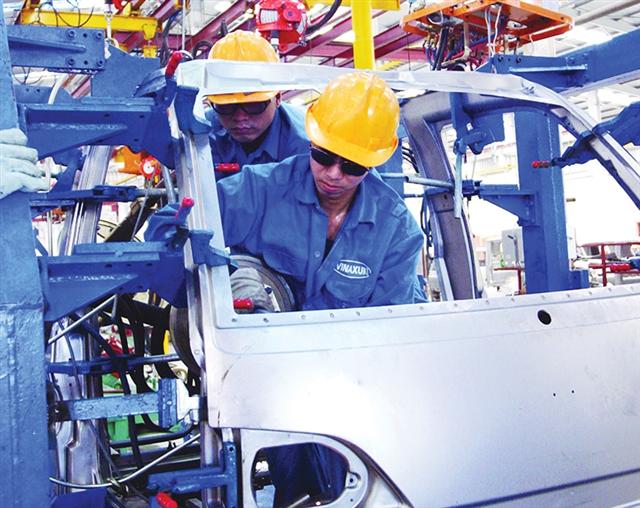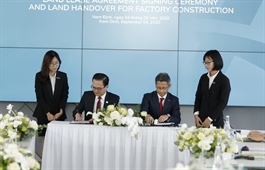Nation accelerates domestic production progress
Nation accelerates domestic production progress
Though resurgence of the pandemic left a grey mark on domestic production which began to bounce back since April, it remains a key driver of economic growth, spearheaded by the processing and manufacturing sector.

Nation accelerates domestic production progress - illustration photo
|
According to the Civil Aviation Administration of Vietnam (CAAV) under the Ministry of Transport (MoT), Vietnam has worked with Japan and South Korea to resume commercial flights from September 15.
“There will be eight flights each week, four with Japan and four with South Korea. All passengers to Vietnam must be isolated for 14 days under the pandemic prevention regulations,” said the CAAV’s director general Dinh Viet Thang.
Prime Minister Nguyen Xuan Phuc earlier ordered the MoT to combine with relevant ministries to soon reopen commercial flights between Vietnam and these two nations, which have a high pandemic-related safety level and currently remain the two largest foreign investors in Vietnam, with South Korea registering $70.1 billion and Japan $60.26 billion.
Besides revitalising the airlines, the resumption of flights with these markets will help Vietnam attract more investment from the north-eastern Asian nations, and spur domestic production, which remains weak due to the pandemic’s revisit, though having begun to recover since April when the country temporarily lifted social distancing measures.
The government last week reported that Vietnam’s industrial production for August “continues facing great difficulties, especially amid the resurgence of the pandemic in late July in the central city of Danang which then expanded to some other localities.”
In August, Vietnam’s index for industrial production (IIP) declined by 0.6 per cent on-year, after a growth of 1.1 per cent in July. This was the first drop in industrial output since May, with output falling for most sectors, such as in mining (-5.1 per cent versus -7.9 per cent in July), processing and manufacturing (-0.1 per cent against 2.1 per cent), and electricity supply (-0.7 per cent versus 2.7 per cent).
As electricity is vital for production, such a decrease would mean local factories are now either standing still or not accelerating again, according to the General Statistics Office (GSO).
In the first eight months, the IIP ascended merely 2.2 per cent, the lowest eight-month increase since 2012 and far lower than the rise of 9.5 per cent in the same period last year. The processing and manufacturing sector creates 80 per cent of Vietnam’s industrial growth and climbed 3.7 per cent on-year.
Meanwhile, the electricity production and distribution sector ascended 2 per cent on-year; and the treatment of wastewater and trash went up 2.9 per cent on-year. All these minor movements are much lower than those in the corresponding period last year.
According to the GSO, the decline in domestic production is attributed to many reasons, for instance, a shrinking consumer market amid the falling global demand. Vietnam also feels this reduced demand due to its openness in the global economy, with GDP doubled by trade turnover.
In the first eight months of this year, Vietnam’s garment and textile sector, which is one of the country’s money makers, earned an export turnover of $19.2 billion, down 11.6 per cent on-year.
It is expected that in the second half of 2020, the sector will suffer a decline of 14-18 per cent in export turnover, with the forecast for the entire year currently standing at $32.75 billion, down 16 per cent on-year.
Pham Viet Minh, sales director of Vietnamese-South Korean Viet Thanh Garment and Textile Co. Ltd., said that after the first eight months, his company’s revenue was down by about 10 per cent.
“No significant orders have been landed with foreign partners who have had to reduce workers and production. In July we were able to ink only a small contract with a South Korean partner. As a result, we have had to lay off hundreds of workers,” Minh said.
Meanwhile, Vietnam’s eight-month export turnover of mobile phones and their spare parts, mostly from Samsung, hit $31.5 billion, accounting for 18.1 per cent of the economy’s total export turnover, and down 5.5 per cent on-year. That of footwear also decreased 8.6 per cent on-year to $10.9 billion.
On-year reductions can also be seen in the export revenues of agricultural items, such as vegetables and fruit ($2.3 billion, down 11.3 per cent), cashews ($2 billion, down 5.4 per cent), coffee ($2 billion, down 1.3 per cent), and tea ($134 million, down 6.2 per cent).
Phuc Sinh Corporation in Ho Chi Minh City has been exporting its farm produce to Europe, North America, and the Middle East for years. Over the past months, the corporation, which holds 15 per cent of Vietnam’s pepper market share, has suffered a reduction of 70 per cent in revenue.
“The sales have dramatically plummeted. We have been deploying online sales, but they are going very slowly,” Phuc Sinh’s chairman and general director Pham Minh Thong told VIR. “Hundreds of thousands of enterprises in Vietnam are finding it hard to boost exports and are seeking new markets,” Thong added. “However, it is not easy to open new markets as it would take time and big sums of money.”
























